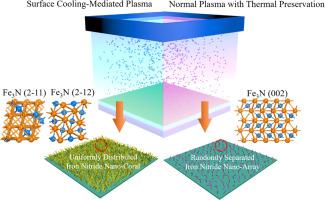Cooling-mediated N2 plasma engineering of facet-selective iron nitride frameworks for enhanced electrocatalysis
IF 14.3
1区 材料科学
Q1 MATERIALS SCIENCE, MULTIDISCIPLINARY
引用次数: 0
Abstract
In-situ plasma processing serves as a cost-effective strategy for modulating surface structure while simultaneously functionalizing material surface, owing to the low-contamination environment and its capability to induce strong surface-substrate interaction. However, current research primarily focuses on correlating plasma discharge parameters with the resultant surface morphology and facet orientation, often overlooking the dynamic evolution of critical parameters during plasma processing, particularly the surface thermal field. This leads to suboptimal surface structure modulation, thereby limiting the practical applicability of plasma-based surface engineering. Herein, we introduce a facile cooling-mediated N2-plasma processing strategy to directly engineer iron nitride nano-framework on Fe surface, while concurrently modulating the surface facets. Operando plasma diagnostics, combined with numerical simulations, are employed to unravel the role of the surface-thermal field in governing the formation of catalytically favorable facets. Given the strong dependence of hydrogen evolution reaction (HER) behavior on surface structure, the resultant iron nitride frameworks via cooling-mediated plasma processing (cFeNC) exhibit improved catalytic performance compared to those fabricated through conventional thermally preserved plasma (hFeN). Density functional theory (DFT) calculations further confirm that the enhanced catalytic behaviors of cFeNC arise from the preferential exposure of highly reactive facets. Our strategy presents a cost-effective pathway for facet engineering of nitride surfaces, providing a promising route towards advanced electrocatalytic materials.

用于增强电催化的面选择性氮化铁框架的冷却介导的N2等离子体工程
原位等离子体处理是一种具有成本效益的策略,可以在调节表面结构的同时使材料表面功能化,因为它具有低污染环境和诱导强表面-衬底相互作用的能力。然而,目前的研究主要集中在等离子体放电参数与表面形貌和面取向的关系上,往往忽略了等离子体加工过程中关键参数的动态演变,特别是表面热场。这导致了次优的表面结构调制,从而限制了等离子体表面工程的实际适用性。在此,我们引入了一种简单的冷却介导的n2等离子体处理策略,直接在Fe表面设计氮化铁纳米框架,同时调制表面facet。Operando等离子体诊断与数值模拟相结合,揭示了表面热场在控制催化有利面形成中的作用。考虑到析氢反应(HER)行为对表面结构的强烈依赖性,通过冷却介导等离子体处理(cFeNC)得到的氮化铁框架比通过传统的热保存等离子体(hFeN)制备的框架具有更好的催化性能。密度泛函理论(DFT)计算进一步证实了cFeNC的催化行为增强是由于高活性面优先暴露所致。我们的策略为氮化物表面的表面工程提供了一条经济有效的途径,为先进的电催化材料提供了一条有前途的途径。
本文章由计算机程序翻译,如有差异,请以英文原文为准。
求助全文
约1分钟内获得全文
求助全文
来源期刊

Journal of Materials Science & Technology
工程技术-材料科学:综合
CiteScore
20.00
自引率
11.00%
发文量
995
审稿时长
13 days
期刊介绍:
Journal of Materials Science & Technology strives to promote global collaboration in the field of materials science and technology. It primarily publishes original research papers, invited review articles, letters, research notes, and summaries of scientific achievements. The journal covers a wide range of materials science and technology topics, including metallic materials, inorganic nonmetallic materials, and composite materials.
 求助内容:
求助内容: 应助结果提醒方式:
应助结果提醒方式:


